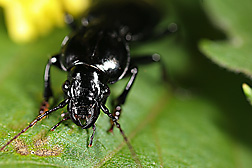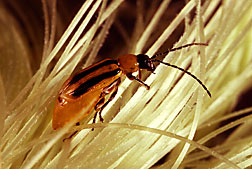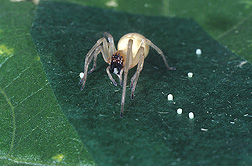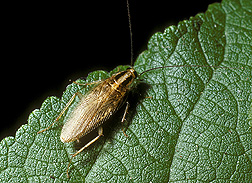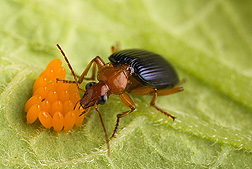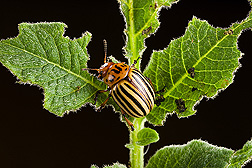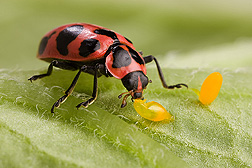Working After Hours
A Nighttime View of Insect Predation
|
|
Growers have much to consider when protecting crops from insect pests. Determining which insects are threats to a crop entails effective sampling to get a good count of the species and life stages of pests and the beneficial insects that prey on them. Natural enemies of crop pests can help growers when efforts are made to conserve and increase their numbers.
It’s becoming apparent that daytime sampling of pests and beneficial insects doesn’t present the full picture for effective natural pest control. Now, thanks to ARS researchers, nocturnal insect activity, particularly beneficial predation, is getting the attention it deserves as an important part of the biological-control puzzle.
What’s Eating the Colorado Potato Beetle?
|
|
Entomologist Don Weber, at the ARS Invasive Insect Biocontrol and Behavior Laboratory in Beltsville, Maryland, focuses on predation of Colorado potato beetle (CPB), a significant pest mainly of potato crops. When only daytime insect populations are counted, some major nocturnal predators of CPB eggs are underestimated or missed. With postdoctoral associate Zsofia Szendrei, Weber studied the activity and feeding patterns of these predators over several 48-hour periods during the 2006-2007 growing season.
The researchers numbered and photographed a total of 240 CPB egg masses before attaching them to leaves of potato plants in a research field. During each 48-hour period, they examined egg masses every 3 hours, looking for damage to the eggs or the presence of beneficial insects on them or nearby.
|
|
Of the many predation events observed, 56 percent occurred after dark, with the fewest observed during the afternoon hours. The most frequently documented predator in the study, larval Chauliognathus sp.—commonly known as the “soldier beetle” or “leatherwing”—had not been previously reported as a CPB egg predator. “This finding identifies another noninsecticidal control to protect crops from Colorado potato beetles,” says Weber.
Adult Lebia grandis—a type of carabid ground beetle—prey only on CPB eggs and larvae and are mostly active at night. Their egg consumption exceeded that of the mainly daytime-active pink spotted ladybeetle (Coleomegilla maculata). True bugs like stink bugs (Perillus and Podisus) and big-eyed bugs (Geocoris) were active almost exclusively during daylight hours.
Nocturnal Predators From Texas
In the past 8 years, entomologist Bob Pfannenstiel and other ARS scientists have been studying the feeding habits of nocturnally active predators of pests in the Lower Rio Grande Valley in south Texas. Pfannenstiel and technicians at the Beneficial Insects Research Unit (BIRU) in Weslaco have done day and night field tests on insects feeding on lepidopteran eggs in cotton, corn, and soybean.
|
|
The predators that feed on moth eggs during the day are very different from those that feed at night, and nighttime predation can be much more important. Two types of nocturnal predator have stood out from the rest: the cursorial (running) spiders, mainly Hibana futilis, and the Asian cockroach, Blattella asahinai.
(For the Asian cockroach work, see “Asian Cockroaches Could Aid Texas Growers,” Agricultural Research, January 2008, p. 11.)
Cursorial spiders consume significant numbers of moth eggs in row crop foliage. About 99 percent of their predation occurs after dark. These spiders are particularly important in cotton, where they benefit from consuming the plant’s sugars. Laboratory and greenhouse studies by BIRU scientists, including entomologists Shoil Greenberg and Randy Coleman, have shown that the spiders also prey on other cotton pests, including the cotton fleahopper, Pseudomatoscelis seriatus, and the cotton plant bug, Creontiades signatus.
|
|
“We’ve found that the cursorial spider prefers the cotton fleahopper, which is smaller than the cotton plant bug. This suggests that the spider has the potential to be an important predator of cotton fleahopper,” says Pfannenstiel.
Pfannenstiel has also frequently observed the cotton fleahopperas a mostly nocturnal predator of lepidopteran eggs in cotton, meaning it can act as both a pest and a predator.
Illuminating Nocturnal Predation
At the ARS North Central Agricultural Research Laboratory in Brookings, South Dakota, entomologist Jonathan Lundgren goes into corn fields late at night and looks for predators that have an appetite for corn rootworms, the most costly pest of corn in the world.
|
|
Since the rootworms do most of their damage during their larval stage, when they live underground, Lundgren confines his observations to the top few inches of soil.
“There is abundant and diverse life underground, with predators including ground beetles, rove beetles, spiders, crickets, and daddy-longlegs.”
Wondering how so many and such diverse species could coexist in the confines of the upper surface of soil near corn roots, Lundgren’s research revealed that the answer might be separation by time. For example, wolf spiders search for rootworms during the night, while some other spiders hunt during the day.
Lundgren also found that one common carabid beetle, Poecilus chalcites, prefers day work, while another, Cyclotrachelus alternans, works a night shift, 10 p.m. to 3 a.m.
|
|
“So even though the two carabid species are abundant in the same confined area, they rarely run into each other in their hunt for rootworms,” Lundgren says.
Lundgren and colleagues have two main ways of spying on predators. First, they go out just after the sun goes down and place about 250 rootworms into the soil near corn roots. They come back 90 minutes later with a red light to see which of their sentinels have been attacked and which predators are hanging around. Most insects are oblivious to red light and carry on with their normal activities despite the observers.
Another tactic is to collect predators every 3 hours from a timed, rotating pitfall trap. Predators that fall in are ground up, and their stomach contents are analyzed for corn rootworm DNA. This gives scientists both the time the predators are hunting and the amount of rootworms they are eating.
Nocturnal predators of pests in many regions and in many crops have yet to be determined. Research on day-active and night-active predators is important to developing strategies that maximize their benefits to crops. To this end, Pfannenstiel and Weber organized a symposium for the Entomological Society of America’s annual meeting in November 2008, entitled “Seizing the Night: Nocturnal Studies of Insect Predation Yield New Insights.”—By Sharon Durham, Alfredo Flores, and Don Comis, Agricultural Research Service Information Staff.
This research is part of Crop Protection and Quarantine, an ARS national program (#304) described on the World Wide Web at www.nps.ars.usda.gov.
Donald C. Weber is with the USDA-ARS Invasive Insect Biocontrol and Behavior Laboratory, 10300 Baltimore Ave., Beltsville, MD 20705; phone (301) 504-8369, fax (301) 504-5104.
Robert S. Pfannenstiel is in the USDA-ARS Beneficial Insects Research Unit, 2413 E. Hwy. 83, Weslaco, TX 78596; phone (956) 969-4858, fax (956) 969-4888.
Jonathan G. Lundgren is with the USDA-ARS North Central Agricultural Research Laboratory, 2923 Medary Ave., Brookings, SD 57006; phone (605) 693-5211, fax (605) 693-5240.
"Working After Hours: A Nighttime View of Insect Predation" was published in the October 2009 issue of Agricultural Research magazine.







